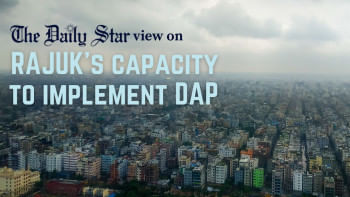Who does Rajuk serve, really?

A recent report in this paper has identified the main reason behind indiscriminate construction in Dhaka as being Rajuk's overindulgence of real estate developers. The result is a concrete jungle with hardly any green spaces, narrow roads, and views blocked by buildings stacked too close to each other. Against this chaotic backdrop, Rajuk has backtracked on the new Detailed Area Plan (DAP) decision imposing height restrictions for buildings. Within just about a year, the DAP has been amended under pressure from real estate giants to increase building heights.
This is quite shocking. The amendment has made allowances that will actually exacerbate the condition of the city's already congested areas. It allows eight-storey buildings in unplanned areas where the limit was six storeys, and in planned areas the limit has been increased to ten storeys from nine. These are some of the relaxations of rules that Rajuk has relented to, catering to the interests of landowners and real estate developers. But what about the interests of ordinary people? Is that of no concern to Rajuk?
Dhaka is being destroyed by this insatiable appetite for real estate development. Residential areas have been turned into commercial areas without any provision for parking, resulting in excruciating gridlocks and lethally poor air quality. How can commercial buildings be built without any parking space? Why should vehicles be forced to park on the road, narrowing it further and increasing the sufferings of the public? Why does Rajuk continue to allow such indiscriminate construction?
The logic given by Rajuk officials – that increasing the FAR (Floor Area Ratio) would motivate landowners to allocate a portion of their land for green space – does not seem to hold much merit. We have seen how real estate development in most areas has been carried out with negligible or non-existent space left for any kind of greenery. In fact, open spaces have been mostly encroached upon and used for construction of structures. There are areas in Dhaka where there are no parks or open spaces for children to play or adults to go to get some reprieve from the chaos around. Urban developers have rightly pointed out that the DAP amendment, which was passed without any consultation with the stakeholders, will lead to more taller buildings, blocked sunlight, poor air circulation and increased congestion, depriving residents of the most basic amenities required for their mental and physical wellbeing. In fact, the recommendations of urban developers to restrict urbanisation in municipalities to protect agricultural land and water bodies have fallen on deaf ears.
The DAP, therefore, has never been implemented, and its recent amendment will allow even more excessive use of land and further loss of whatever little greenery that is left. Rajuk must answer for helping to turn Dhaka into one of the most challenging places to live in this world.


 For all latest news, follow The Daily Star's Google News channel.
For all latest news, follow The Daily Star's Google News channel. 






Comments